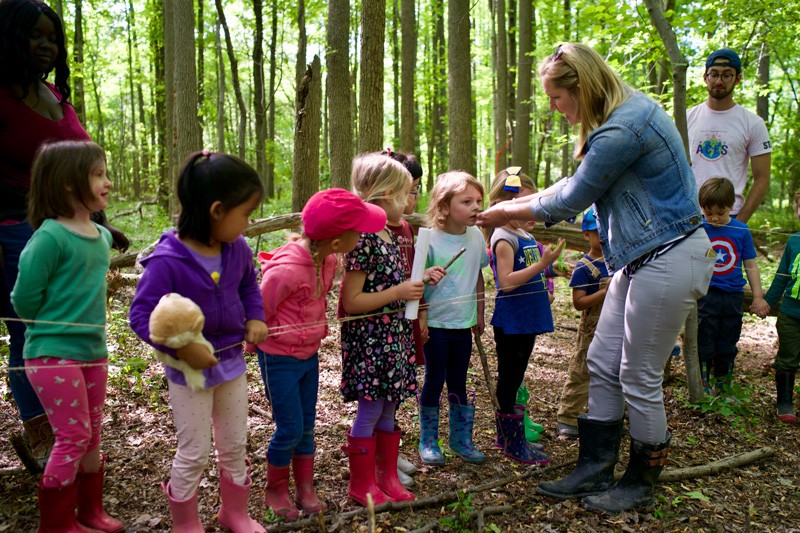Lab School
Edible Forest Garden

June 24, 2019
UD students learn and help staff teach children where food comes from
On an overcast Saturday morning, staff and volunteers gathered at the Early Learning Center and Laboratory Preschool, both located on the University of Delaware’s Children’s Campus. With shovels and wheelbarrows in hand, they set about installing an edible forest garden.
This multilayer collection of fruit and nut trees, legumes, shrubs, roots and vegetables is comprised of many plants that provide at least one component — berries, leaves or other produce — that is edible with proper care and preparation. Additional plants provide vital services like attracting pollinators or providing nutrients to the soil and surrounding garden. Students at the Children’s Campus will learn about garden maintenance, food production and preparation. They’ll have an opportunity to explore and experience the smell, texture and taste of the plants as they grow.
“An edible forest garden is a layered garden or designed landscape that incorporates perennial groupings of plants to imitate a low-maintenance natural forest. You can differentiate this from your typical community vegetable garden because that would be something that would require annual maintenance and replanting,” said Anna Wik, assistant professor of landscape architecture in the College of Agriculture and Natural Resources. “In this case, we’re creating something that children can interact with year-round. They’ll be able to talk about the life cycle of plants and see things truly bear fruit year in and year out.”
On that Saturday morning, the rain started out as a misty nuisance before growing into a steady downpour. Outfitted with rain ponchos and gardening gloves, the volunteers got to work distributing a truckload of topsoil to each of the new gardens, located at seven locations throughout the Children’s Campus. The volunteers numbered more than wheelbarrows, so the staff got creative, bringing out buckets and red wagons from the toddler playground to help move the soil.
Over the next few hours, volunteers installed nearly 200 plants and over 500 deep root landscape plugs that will eventually grow into UD’s first edible forest garden.
Building a forest
The garden planting is a major milestone in this cross-disciplinary project. Supported by a seed grant from the Center for Food Systems and Sustainability (CENFOODS), the edible forest garden is the culmination of a group effort from students, faculty and staff across five colleges and the University of Delaware Cooperative Extension.
“We’re a new Center on campus. We’re not specific to food and not specific to environmental sustainability; we’re really thinking about how the food system can be done in a way that’s more sustainable for society,” said Angelia Seyfferth, director of CENFOODS and associate professor of biogeochemistry and plant-soil interactions. “In addition to an internship program, the center integrates research, education, and community outreach. My hope is that we become an organization that provides internships and opportunities for undergraduates to be involved in research and local projects.”
True to that vision, interns were at the helm of this project, gaining valuable work experience and honing their leadership skills. Sophomore Eduardo Limon and senior Jenna Simons were tasked with landscape design and plant selection. Senior Scott Walls led community engagement and recent alumnus Troy Saltiel used GIS to map productive landscapes across campus and document every plant in the edible forest garden design. Additional interns will draft a garden management plan this summer.
“This project was a really good opportunity for me to learn about native species and how their roots work, and to learn about the ecosystems we need to create to have successful gardens,” said landscape architecture student Eduardo Limon. “My goal is to become a licensed landscape architect and to create ecosystems that enhance the relationships between plants, animals, and people in the same landscape.”
Designing the edible forest garden was no small feat. Interns were fully immersed in what it means to be a landscape architect and had to learn and observe the needs of the client – in this case the children and teachers at the Children’s Campus.
“We were thinking about the landscape and the soil conditions, as well as how this design can be useful for children. I’ve visited two or three times to see how children play out here,” said Limon. “We brought ideas together and came up with some sketches. Then we started to think of various ways to design these places.”
